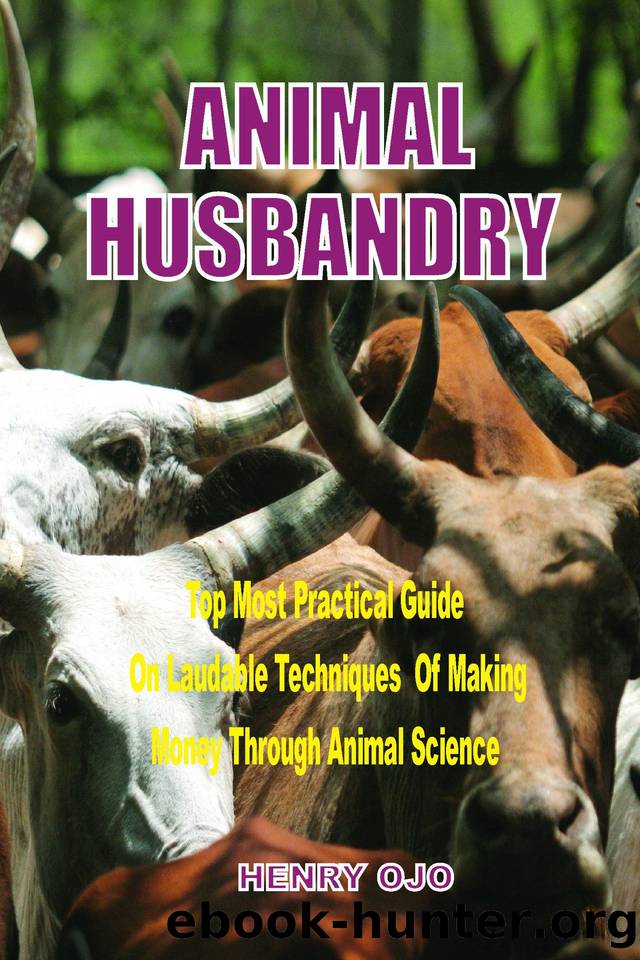Animal Husbandry: Top Most Practical Guide on Laudable Techniques of Making Money through Animal Science by Ojo Henry

Author:Ojo, Henry [Ojo, Henry]
Language: eng
Format: epub
Publisher: Jomakins
Published: 2017-11-02T00:00:00+00:00
CHAPTER SIX
GRASSCUTTER
(Thryonomys swinderianus and Thryonomys gregorianus)
The grasscutter is found in many forests and savannas of Africa. Its meat, said to resemble suckling pig often, sells far more per kilogram than chicken, beef, pork or lamb. It is the preferred, and perhaps most expensive, meat in West Africa. Indeed in Ivory coast it sells for about $9.00 per kg. With prices like that, grasscutter is a culinary luxury that only the wealthy can afford.
If domestication of this wild species were successful in providing meat at a price similar to that of poultry, (the second most popular meat), markets would be unlimited. However, as production costs are high, long-term research will be required before grasscutter production can be profitable to the small farmer.
In an effort to capitalize on the markets for this delicacy, agricultural extension services of Cameroon, Ghana, Ivory Coast, Nigeria, Togo and particularly Benin are already encouraging farmers to rear grasscutter as backyard livestock. They furnish breeding stock and information, and maintain central offices for records. In addition, a bilateral cooperation project in Benin has started experimental work on improved breeding methods combined with the study of animal responses under domestication.
In future, this vegetarian animal might becOme the African equivalent of South Americaâs guinea pig, playing an important role in reducing Africaâs protein shortage.
AREA OF POTENTIAL USE
The area of potential use of grasscutter are the Humid and Sub-humid Africa South of the Sahara.
APPEARANCE AND SIZE
Grasscutters are robust animals with short tails, small ears, and stocky bodies. Taxonomically, they are more closely related to porcupines than to common rats or mice.
Although many varieties have been described, there are probably only two species. The larger (Thryonomys swinderianus) weigh.s 9kg or more and has a head and body length of up to 60cm. The smaller species ( Thryonomy gregorianus) may occasionally reach 8kg and a body of length of 50cm.
Both species have yellow-brown to grey-brown bodies with whitish belies. The fur is extremely coarse firm, and bristly â reflecting the animals kinship to the porcupine. The tail is scaly and has short, sparse hairs.
Both species have thick, heavy claws and enormous orange incisors that can chew through even the toughest vegetation. They tear holes in corrugated iron fences. Nevertheless, they do not bite when handled, although their claws sometimes cause injuries.
DISTRIBUTION
Grasscutters occur in grasslands or in wooded savanna throughout the humid and sub humid areas of Africa South of the Sahara. They often live in forest â Savanna habitats where grass is present. They do not inhabit rain forest, dry scrub or desert, but they have colonized the road boarders in forest regions. Distribution is determined by availability of adequate or preferred grass species for food. Specifically, Thryonomys swinderianus occurs in virtually all countries of West, East, and Southern Africa. Thryonomys gregorianus occurs in savannas in Cameroon, Central Africa Republic, Rep. of Congo, Sudan, Ethiopia, Kenya, Uganda, Tanzania, Malawi, Zambia, Zimbabwe and Mozambique.
STATUS
Despite heavy hunting, these animals are not threatened with extinction.
Nonetheless, many individual populations are well below carrying capacity, or are extinct because of local over exploitation.
Download
This site does not store any files on its server. We only index and link to content provided by other sites. Please contact the content providers to delete copyright contents if any and email us, we'll remove relevant links or contents immediately.
The Lonely City by Olivia Laing(4567)
Animal Frequency by Melissa Alvarez(4148)
All Creatures Great and Small by James Herriot(3985)
Walking by Henry David Thoreau(3681)
Exit West by Mohsin Hamid(3634)
Origin Story: A Big History of Everything by David Christian(3472)
COSMOS by Carl Sagan(3346)
How to Read Water: Clues and Patterns from Puddles to the Sea (Natural Navigation) by Tristan Gooley(3239)
Hedgerow by John Wright(3106)
How to Do Nothing by Jenny Odell(3101)
The Inner Life of Animals by Peter Wohlleben(3099)
How to Read Nature by Tristan Gooley(3077)
Project Animal Farm: An Accidental Journey into the Secret World of Farming and the Truth About Our Food by Sonia Faruqi(3016)
Origin Story by David Christian(2991)
Water by Ian Miller(2950)
A Forest Journey by John Perlin(2914)
The Plant Messiah by Carlos Magdalena(2745)
A Wilder Time by William E. Glassley(2689)
Forests: A Very Short Introduction by Jaboury Ghazoul(2671)
